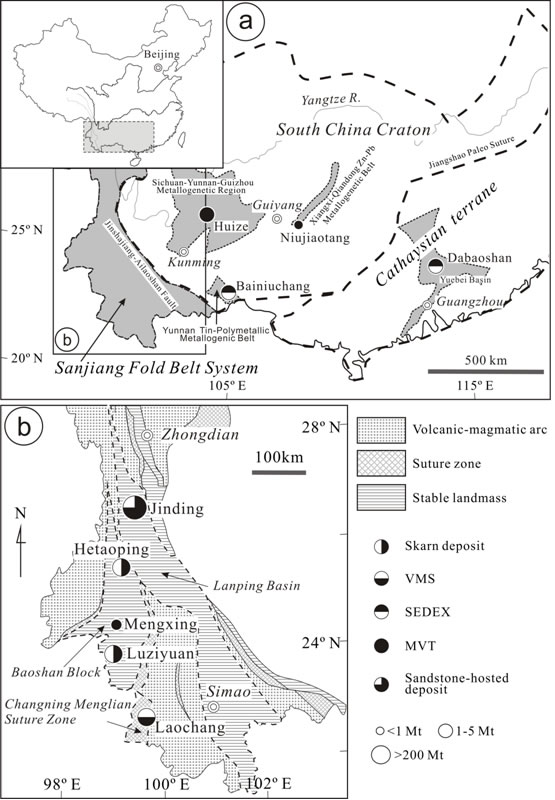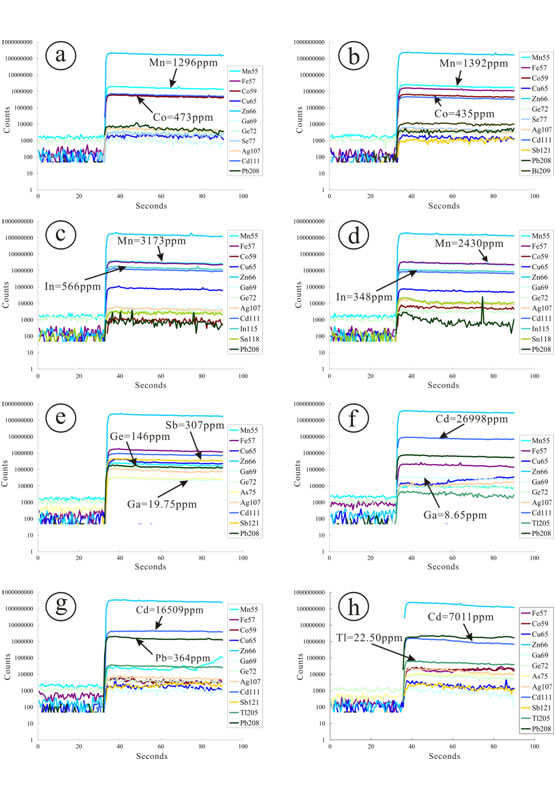As one of the important ore mineral in Pb-Zn deposits, sphalerite is rich in trace elements (e.g. Fe, Mn, Cd, Ga, Ge, In, Se and Te) which can provide much useful genetic information. For a long time, many researchers have tried to use the trace elements to assign genetic types of Pb-Zn deposits, but little effect has been produced. The main reasons are the difference and the accuracy of the analysis method. Recently, with the applications of high precision LA-ICPMS in geological research, in-situ analysis of trace elements of sulfide minerals becomes possible. It opens up a new way for the research on trace elements of sulfide minerals.
Supported by Visiting Scholar Project, Chinese Academy of Sciences, Associate Professor YE Lin in IGCAS has started cooperation with Professor Nigel J. Cook and Dr. Cristiana L. Ciobanu in School of Earth and Environmental Sciences, Adelaide University, Australia since 2010. Analyzed by the Agilent HP-7700 Quadruple ICPMS instrument at CODES (University of Tasmania, Hobart, Australia), the trace and minor elements in sphalerite from base metal deposits in South China (e.g. Hetaoping, Lunziyuan, Bainiuchang, Mengxing, Huize, Jinding and Laochang in Yunnan province, Niujiaotang in Guizhou province and Dabaoshan in Guangdong province) were researched. Their researches have borne the following fruits:
1. The geochemistry of sphalerite from 9 deposits of different age and metallogenic province in South China can be used to assign them into genetic types (skarn, syngenetic massive sulphide, MVT-type), even when their origin is debated based on other criteria.
2. Sphalerite from each genetic class of deposit shows a distinct chemical signature. The skarns feature high Co and Mn; their distal character is reflected by low In. The syngenetic massive sulphides have In, Sn and Ga and the MVT-type are enriched in Ge, Cd, Tl and As.
3. Given the refractory character of sphalerite, trace element analysis of sphalerite shows promise as a tracer of overprinting, which may assist in defining the geochemical signature of different metallogenic epochs in a region as geologically complex as South China.
4. The time-resolved depth profiles for sphalerite from the Chinese deposits document solid solution for a number of trace elements whose ability to enter the crystal structure of sphalerite has been previously debated (Ag, Sn, Tl, Sb).
The above research achievement was published in ‘Ore Geology Review’ recently (Lin Ye, Cook N J, Ciobanu C L, Liu Y P, Zhang Q, Liu T G, Gao W, Yang Y L, Danyushevskiy L.2011. Trace and minor elements in sphalerite from base metal deposits in South China: a LA-ICPMS study. Ore Geology Review, 39:188-217)

Fig. 1. (a) Geological sketch map of Southern China showing the location and tectonic setting of the deposits studied. The inset (b) is an enlargement of the Sanjiang Fold Belt. Maps are redrawn after Wang (1993), Zhou et al. (1998), Zhang et al. (2005), Hou et al. (2007) and Pan et al. (2009).

Fig. 2. Histograms showing the variation in (a) Cd, (b) Co, (c) Ga, (d) In, and (e) Mn in sphalerite from Pb-Zn deposits in Southern China.
Fig. 3. Binary plots of (a) In vs. Ge, (b) In vs. Fe, (c) In vs. Cu, (d) In vs. Sn, (e) Cu vs. Sn, (f) (Cu+Ag) vs. (In+Sn), (g) Fe vs. Mn and (h) Fe vs. Cd, in sphalerite from Pb-Zn deposits in South China. Inset on (c) illustrates the relationship between In and Cu in Dabaoshan sphalerite only.

Fig. 4. Representative time-resolved depth profiles for sphalerite analysed in this study showing flat spectra indicative of solid solution; see text for additional explanation. (a) Hetaoping. (b) Luziyuan. (c) Dabaoshan. (d) Laochang. (e) Huize. (f) Niujiaotang. (g) Mengxing. (h) Jinding.
(By YE Lin)